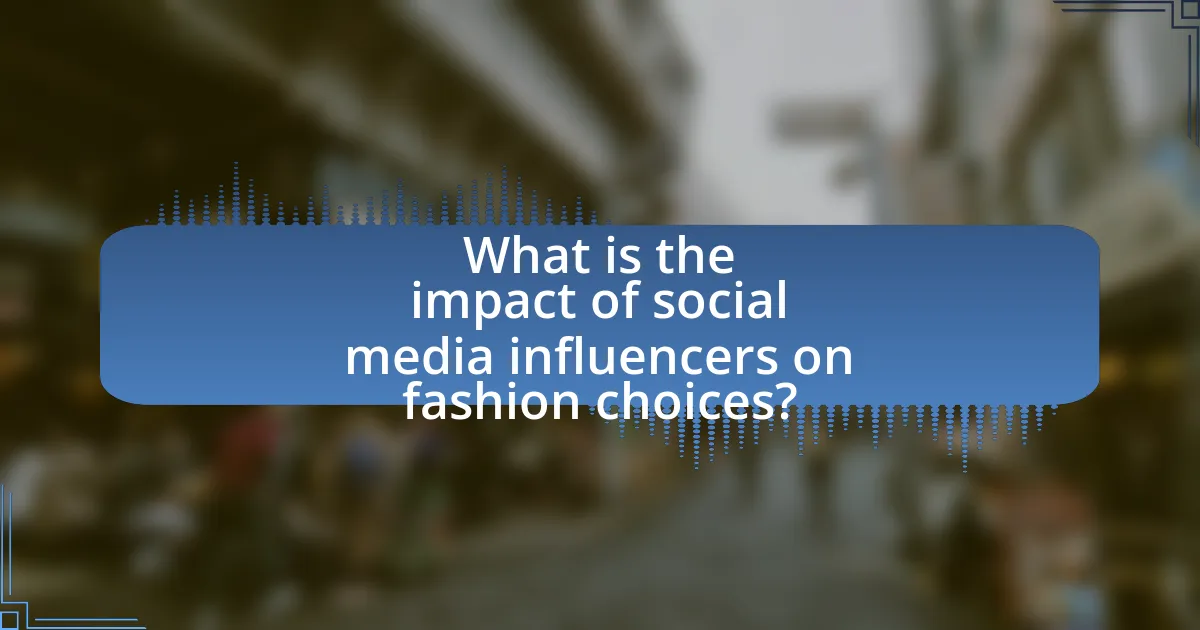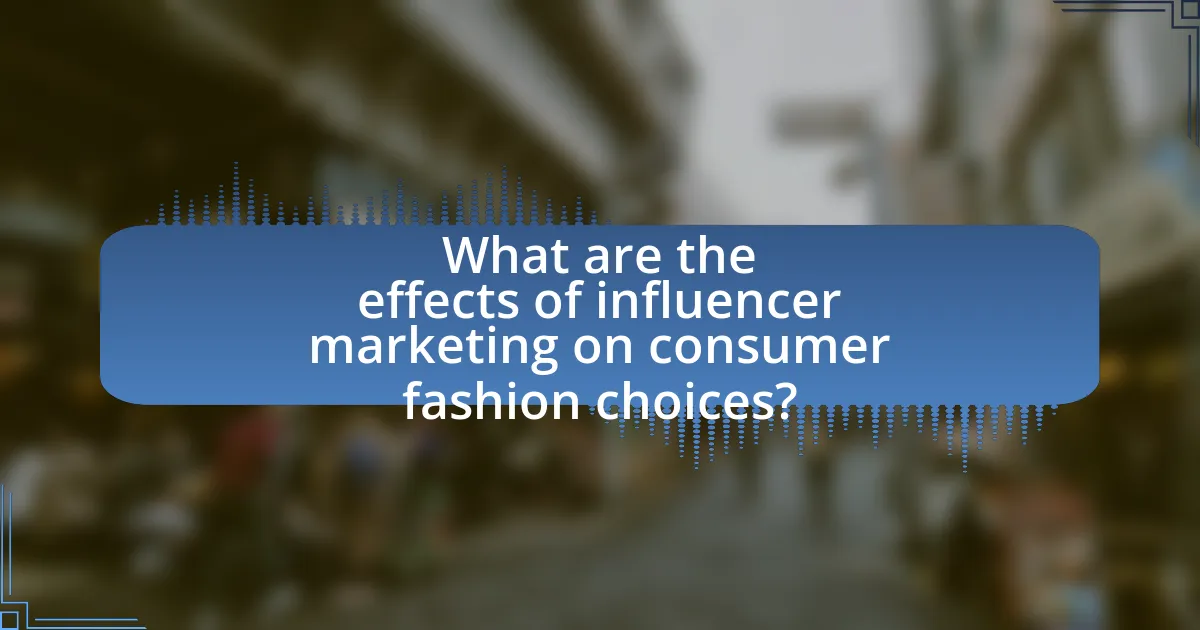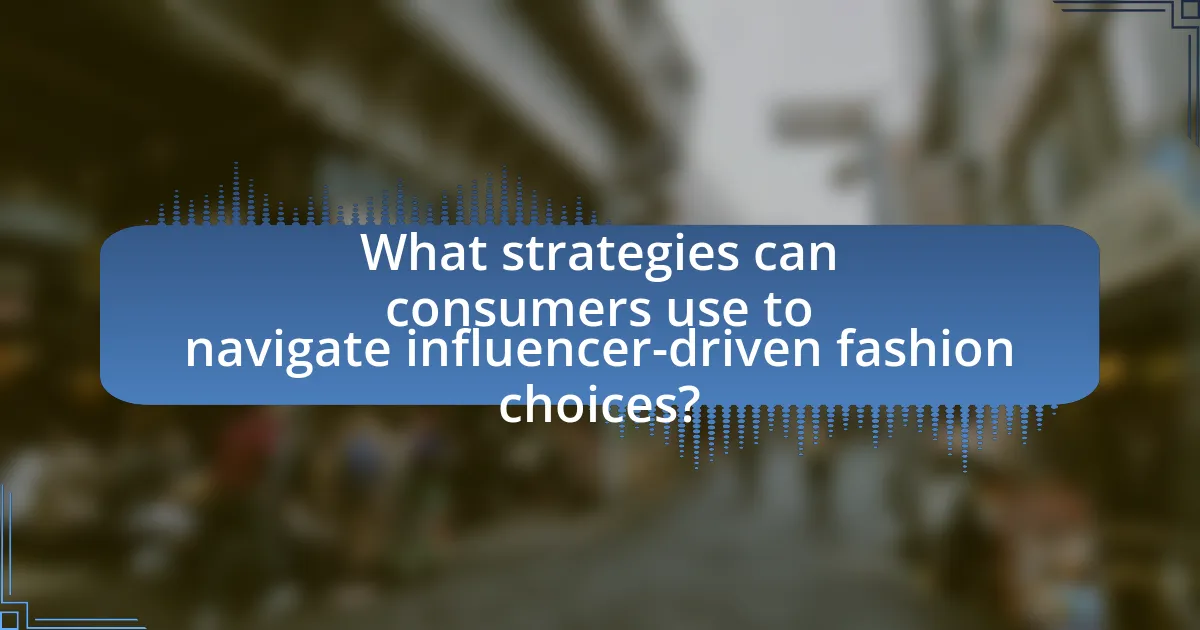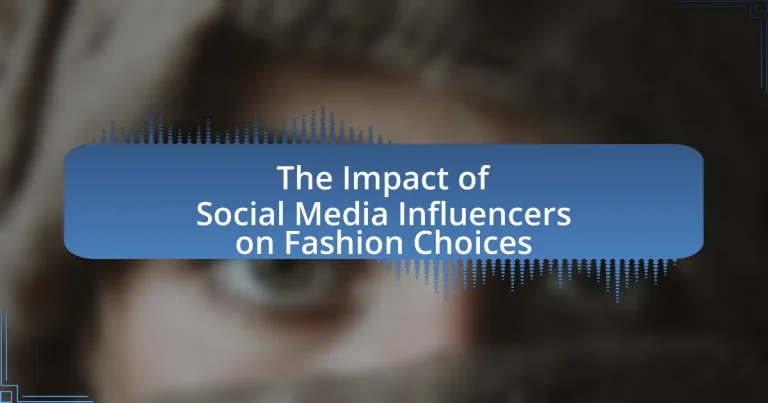The article examines the significant impact of social media influencers on fashion choices, highlighting their role in shaping consumer behavior and driving purchasing decisions. It discusses how influencers create trends, the psychological factors influencing followers’ fashion preferences, and the various types of influencers, including micro and celebrity figures. Additionally, the article addresses the ethical considerations surrounding influencer marketing, the importance of authenticity and transparency, and strategies for consumers to navigate influencer-driven fashion choices effectively. Key metrics for evaluating the effectiveness of influencer marketing in the fashion industry are also outlined, emphasizing the need for critical evaluation by consumers.

What is the impact of social media influencers on fashion choices?
Social media influencers significantly shape fashion choices by promoting trends and brands to their followers. Their ability to reach large audiences through platforms like Instagram and TikTok allows them to create a sense of aspiration and desirability around specific styles and products. Research indicates that 49% of consumers rely on influencer recommendations for their purchasing decisions, highlighting the persuasive power these influencers hold in the fashion industry. Additionally, a study published in the Journal of Business Research found that influencer marketing can lead to increased brand awareness and consumer engagement, further solidifying their impact on fashion choices.
How do social media influencers shape consumer behavior in fashion?
Social media influencers shape consumer behavior in fashion by leveraging their reach and credibility to affect purchasing decisions. Their ability to create aspirational content and showcase products in relatable contexts leads to increased brand awareness and consumer trust. For instance, a study by the Digital Marketing Institute found that 49% of consumers depend on influencer recommendations when making fashion purchases. Additionally, influencers often engage their followers through interactive content, such as polls and Q&A sessions, which fosters a sense of community and encourages followers to emulate their style choices. This dynamic not only drives immediate sales but also cultivates long-term brand loyalty among consumers.
What psychological factors influence followers’ fashion choices?
Psychological factors influencing followers’ fashion choices include social identity, conformity, and self-esteem. Social identity theory suggests that individuals choose fashion that aligns with their desired group affiliations, enhancing their sense of belonging. Conformity drives followers to adopt styles endorsed by influencers to fit in with perceived social norms, as evidenced by studies showing that individuals often mimic the fashion choices of those they admire. Additionally, self-esteem plays a crucial role; followers may select clothing that boosts their confidence or reflects their self-image, supported by research indicating that fashion choices can significantly impact an individual’s self-perception and mood.
How do influencers create trends in the fashion industry?
Influencers create trends in the fashion industry by leveraging their social media platforms to showcase styles and products that resonate with their followers. They often collaborate with brands to promote specific items, which can lead to increased visibility and desirability. For instance, a study by the Digital Marketing Institute found that 49% of consumers depend on influencer recommendations when making purchase decisions, highlighting their significant impact on consumer behavior. Additionally, influencers often set the tone for seasonal trends by curating outfits that reflect current fashion movements, thus shaping public perception and driving sales in the fashion market.
Why are social media influencers important in the fashion industry?
Social media influencers are important in the fashion industry because they shape consumer perceptions and drive purchasing decisions. Their ability to reach large audiences through platforms like Instagram and TikTok allows them to showcase trends and products in a relatable manner, making fashion more accessible. According to a 2021 survey by the Digital Marketing Institute, 49% of consumers rely on influencer recommendations for their purchasing decisions, highlighting their significant impact on consumer behavior. Additionally, influencers often collaborate with brands, providing authentic endorsements that resonate with their followers, further solidifying their role as key players in the fashion landscape.
What role do influencers play in brand marketing strategies?
Influencers play a crucial role in brand marketing strategies by acting as trusted intermediaries between brands and consumers. They leverage their established credibility and large followings to promote products, thereby enhancing brand visibility and driving consumer engagement. Research indicates that 49% of consumers depend on influencer recommendations when making purchase decisions, highlighting their significant impact on consumer behavior. Additionally, brands that collaborate with influencers often experience higher conversion rates, as influencers can effectively communicate brand values and create authentic connections with their audience.
How do influencers affect the visibility of fashion brands?
Influencers significantly enhance the visibility of fashion brands by leveraging their large and engaged followings on social media platforms. Their endorsements and authentic content create a direct connection between the brand and potential customers, often leading to increased brand awareness and consumer interest. For instance, a study by the Digital Marketing Institute found that 49% of consumers depend on influencer recommendations when making purchase decisions, highlighting the effectiveness of influencers in shaping consumer behavior. Additionally, brands that collaborate with influencers often experience a boost in social media engagement, as posts featuring influencers can generate up to 10 times more engagement than traditional advertising methods. This demonstrates that influencers play a crucial role in amplifying the reach and visibility of fashion brands in a competitive market.
What are the different types of social media influencers in fashion?
The different types of social media influencers in fashion include fashion bloggers, fashion vloggers, celebrity influencers, micro-influencers, and brand ambassadors. Fashion bloggers typically share their style through written content and images on platforms like Instagram and personal websites, while fashion vloggers create video content showcasing outfits and styling tips on platforms like YouTube. Celebrity influencers leverage their fame to promote fashion brands, often resulting in significant reach and engagement. Micro-influencers, who have smaller but highly engaged followings, often focus on niche markets and can drive authentic connections with their audience. Brand ambassadors represent specific fashion brands, promoting products through their social media channels and often participating in marketing campaigns. These categories reflect the diverse ways influencers impact fashion choices and consumer behavior.
How do micro-influencers differ from macro-influencers in fashion?
Micro-influencers differ from macro-influencers in fashion primarily in their audience size and engagement levels. Micro-influencers typically have between 1,000 to 100,000 followers, allowing for more niche targeting and higher engagement rates, often exceeding 7% per post, compared to macro-influencers, who have over 100,000 followers and generally experience lower engagement rates around 1-3%. This difference in engagement is significant because brands often find that micro-influencers can create more authentic connections with their audience, leading to higher conversion rates for fashion products. Studies indicate that consumers are more likely to trust recommendations from influencers with smaller, more engaged followings, as they perceive them as more relatable and trustworthy.
What impact do celebrity influencers have compared to everyday influencers?
Celebrity influencers have a significantly greater impact on fashion choices compared to everyday influencers due to their extensive reach and established authority in the industry. Research indicates that celebrity endorsements can increase consumer purchasing intentions by up to 37%, as their fame and status often create a perception of higher quality and desirability in products. In contrast, everyday influencers, while relatable, typically have a smaller audience and may not evoke the same level of aspirational appeal. A study published in the Journal of Advertising Research found that consumers are more likely to trust and follow fashion trends set by celebrities, as they are perceived as trendsetters, which reinforces the notion that celebrity influencers drive more substantial shifts in fashion choices than their everyday counterparts.
How do social media platforms facilitate influencer impact on fashion choices?
Social media platforms facilitate influencer impact on fashion choices by providing a direct channel for influencers to showcase their style and engage with their audience. These platforms, such as Instagram and TikTok, allow influencers to share visually appealing content, including outfit inspirations and styling tips, which can significantly shape their followers’ fashion preferences. According to a study by the American Marketing Association, 49% of consumers rely on influencer recommendations for their purchasing decisions, highlighting the effectiveness of this medium in influencing fashion choices. Additionally, the interactive nature of social media enables influencers to build personal connections with their audience, fostering trust and encouraging followers to emulate their fashion sense.
What challenges do influencers face in the fashion industry?
Influencers in the fashion industry face several challenges, including maintaining authenticity, managing brand partnerships, and navigating the fast-paced nature of trends. Authenticity is crucial, as followers expect genuine content; however, influencers often struggle to balance personal style with brand expectations, leading to potential conflicts. Additionally, managing multiple brand partnerships can create pressure to consistently produce engaging content while adhering to contractual obligations. The rapid evolution of fashion trends further complicates their role, as influencers must quickly adapt to stay relevant, which can lead to burnout and decreased creativity. These challenges highlight the complexities of their influence in shaping fashion choices.

What are the effects of influencer marketing on consumer fashion choices?
Influencer marketing significantly affects consumer fashion choices by shaping perceptions and driving purchasing decisions. Research indicates that 49% of consumers rely on influencer recommendations for their fashion purchases, highlighting the trust and credibility influencers hold in the eyes of their followers. Additionally, influencers often create a sense of urgency and exclusivity around fashion items, leading to increased demand and sales. A study published in the Journal of Advertising Research found that consumers exposed to influencer marketing are 2.4 times more likely to make a purchase compared to those who are not. This demonstrates the powerful role influencers play in guiding consumer behavior within the fashion industry.
How do influencers affect purchasing decisions among their followers?
Influencers significantly affect purchasing decisions among their followers by leveraging their credibility and relatability to promote products. Research indicates that 49% of consumers depend on influencer recommendations when making purchasing decisions, highlighting the trust followers place in these figures. Additionally, influencers often create a sense of community and belonging, which can drive followers to purchase products to align with the lifestyle portrayed. A study published in the Journal of Marketing Research found that social proof from influencers can increase the likelihood of purchase by 30%, demonstrating the tangible impact influencers have on consumer behavior.
What metrics indicate the effectiveness of influencer marketing in fashion?
Key metrics indicating the effectiveness of influencer marketing in fashion include engagement rate, reach, conversion rate, and return on investment (ROI). Engagement rate measures the level of interaction (likes, comments, shares) relative to the audience size, reflecting how well the content resonates with followers. Reach quantifies the total number of unique users who see the influencer’s content, providing insight into brand visibility. Conversion rate tracks the percentage of users who take a desired action, such as making a purchase after engaging with the influencer’s content, demonstrating direct impact on sales. ROI evaluates the financial return generated from influencer campaigns compared to the costs incurred, helping brands assess overall effectiveness. According to a 2021 study by Influencer Marketing Hub, businesses earn an average of $5.78 for every dollar spent on influencer marketing, underscoring the financial benefits of effective campaigns.
How do followers perceive authenticity in influencer recommendations?
Followers perceive authenticity in influencer recommendations primarily through the perceived transparency and relatability of the influencer. When influencers share personal experiences, demonstrate genuine use of products, and engage openly with their audience, followers are more likely to view their recommendations as authentic. Research indicates that 61% of consumers trust influencer recommendations over brand advertisements, highlighting the importance of perceived authenticity in influencing purchasing decisions. Additionally, followers often assess authenticity based on the influencer’s alignment with their own values and lifestyle, further reinforcing the connection between authenticity and effective recommendations.
What are the ethical considerations surrounding influencer marketing in fashion?
The ethical considerations surrounding influencer marketing in fashion include transparency, authenticity, and the potential for promoting unrealistic beauty standards. Transparency is crucial as influencers must disclose paid partnerships to maintain trust with their audience; the Federal Trade Commission mandates this disclosure in the United States. Authenticity is also vital, as followers often seek genuine recommendations, and influencers who promote products they do not genuinely use can mislead consumers. Furthermore, influencer marketing can perpetuate unrealistic beauty standards, impacting body image and self-esteem among followers, particularly young audiences. Research indicates that exposure to idealized images can lead to negative body image and disordered eating behaviors, highlighting the responsibility influencers have in their marketing practices.
How do transparency and disclosure impact consumer trust?
Transparency and disclosure significantly enhance consumer trust by providing clear and honest information about products and brand practices. When brands openly share details regarding their sourcing, manufacturing processes, and partnerships with influencers, consumers feel more informed and empowered to make purchasing decisions. Research by the Digital Marketing Institute indicates that 94% of consumers are likely to be loyal to a brand that offers complete transparency. This trust is further reinforced when influencers disclose paid partnerships or sponsorships, as it fosters authenticity and credibility in their recommendations. Consequently, transparency and disclosure create a foundation for stronger consumer relationships and brand loyalty in the fashion industry.
What are the potential negative effects of influencer culture on body image?
Influencer culture can negatively affect body image by promoting unrealistic beauty standards and fostering comparison among individuals. This culture often showcases edited and curated images that depict idealized body types, leading to feelings of inadequacy and low self-esteem in viewers. Research published in the journal “Body Image” indicates that exposure to idealized images on social media correlates with increased body dissatisfaction and disordered eating behaviors among adolescents. Furthermore, a study by Fardouly et al. (2015) found that women who viewed images of influencers reported higher levels of body shame and a desire to lose weight. These findings highlight the detrimental impact of influencer culture on individuals’ perceptions of their own bodies.

What strategies can consumers use to navigate influencer-driven fashion choices?
Consumers can navigate influencer-driven fashion choices by critically evaluating the authenticity and relevance of the influencers they follow. This involves researching the influencer’s background, assessing their engagement with followers, and determining if their style aligns with the consumer’s personal preferences and values. Studies indicate that consumers who engage in this critical evaluation are less likely to make impulsive purchases influenced by trends, leading to more sustainable fashion choices. For instance, a survey by the American Psychological Association found that 70% of consumers reported feeling more confident in their purchases when they researched the influencer’s credibility and style compatibility.
How can consumers critically evaluate influencer recommendations?
Consumers can critically evaluate influencer recommendations by assessing the influencer’s credibility, analyzing the authenticity of the content, and considering the potential biases involved. Credibility can be determined by examining the influencer’s expertise in the fashion industry, their follower engagement rates, and their history of providing reliable information. Authenticity can be evaluated by looking for signs of genuine use of the product, such as personal testimonials or unedited content, rather than overly polished promotional material. Additionally, consumers should be aware of potential biases, such as financial incentives or sponsorships, which can affect the influencer’s objectivity. Research indicates that 61% of consumers trust influencer recommendations more than brand advertisements, highlighting the importance of critical evaluation to avoid being misled.
What signs indicate a genuine influencer versus a promotional one?
Genuine influencers typically exhibit authenticity, engagement, and consistency, while promotional influencers often prioritize brand partnerships over personal connection. Authenticity is demonstrated through personal storytelling and relatable content, which fosters trust among followers. Engagement is evident in meaningful interactions with their audience, such as responding to comments and participating in discussions, indicating a genuine interest in their community. Consistency in posting style and message reinforces their brand identity, distinguishing them from promotional influencers who may frequently shift their focus based on sponsorships. Research shows that 86% of consumers consider authenticity important when deciding which brands to support, highlighting the value of genuine influencers in shaping fashion choices.
How can consumers balance trends with personal style?
Consumers can balance trends with personal style by selectively incorporating trending items that resonate with their individual preferences. This approach allows consumers to stay fashionable while maintaining authenticity. For instance, a study by the Fashion Institute of Technology found that 70% of consumers prefer to mix trendy pieces with their existing wardrobe to create a unique look. By doing so, they can express their identity while still engaging with current fashion movements.
What best practices should brands follow when collaborating with influencers?
Brands should prioritize authenticity and alignment with influencers when collaborating. This involves selecting influencers whose values and audience resonate with the brand’s identity, ensuring a genuine connection that enhances credibility. Research indicates that 92% of consumers trust recommendations from individuals over brands, highlighting the importance of authentic partnerships. Additionally, brands should establish clear communication and expectations regarding content, deliverables, and compensation to foster a productive relationship. Regularly analyzing campaign performance metrics, such as engagement rates and conversion statistics, allows brands to refine their strategies and maximize the impact of influencer collaborations.
How can consumers make informed fashion choices in the age of influencers?
Consumers can make informed fashion choices in the age of influencers by critically evaluating the authenticity and credibility of the influencers they follow. Research indicates that 61% of consumers trust influencer recommendations more than brand advertisements, highlighting the significant impact influencers have on purchasing decisions. To ensure informed choices, consumers should verify the influencer’s expertise in fashion, assess the transparency of sponsored content, and seek diverse opinions from multiple sources. Additionally, utilizing tools like reverse image search can help consumers identify the origin of fashion items and compare prices across platforms, further enhancing their decision-making process.


